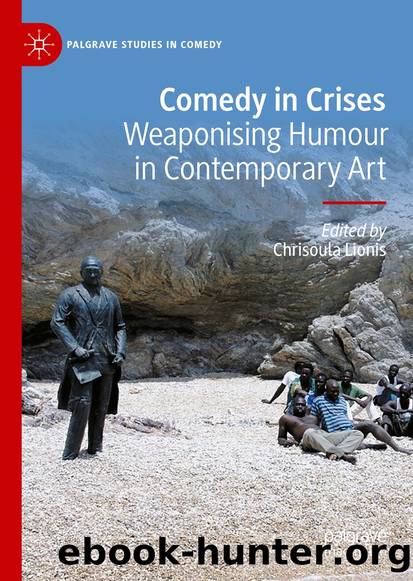Comedy in Crises by Unknown

Author:Unknown
Language: eng
Format: epub
ISBN: 9783031189616
Publisher: Springer International Publishing
Humour and Art of Its âTimeâ: Context and Temporality
Jokes are subjective and âof their timeâ. What one might have found funny in the nineteenth century may now be considered outdated or rude; what one culture laughs at, another may not. For this reason, it is crucial when looking at visual art to consider how our personal and cultural backgrounds influence our ability to register, understand and appreciate strategies of humour in a work (Klein 2007, p. 11). Thus, humour, like all culture, is a form of discourse or social construction.
For centuries, laughter has been deemed immoral because of its capacity to incite a loss of control and as a form of asserting power (Morreall 1983, pp. 85â88). In philosophy, Charles Baudelaire (following Thomas Hobbes) considers laughter to be founded on the feeling of superiority of one over another or of one being ridiculed (Baudelaire 1956). Theodor Adorno (2001) was also critical of humour, considering culture an industry and laughter almost as mass-produced, therefore losing its agency. To consider Adornoâs point, one thinks, for example, of live audiences in the theatre, cinema or televised shows, where unified laughter is encouraged, âpushing pluralism into monism, obliterating individuality for the sake of eliminating fearâ (Coulson 2007, p. 147). In this instance, humour lacks the ability to protest. Shea Coulson analyses the potential of laughter in âartââin the wider sense, not necessarily âfine artâ or just visual cultureâto affect change using Adornoâs theories of laughter. For Coulson, âThe comic in art must remain mute, for otherwise it would succumb to the culture industry's dominating laughterâ (2007, p. 150). In other words, the joke must remain somewhat outside of societal norms to retain its agency. Otherwise, artâs straddling of nature and commodity falls prey to the âindustryâ (Coulson 2007, p. 149). In this regard, it is pertinent to remember that the artworld is a capitalist infrastructure, and art is often a commodity. Humour provides a way of challenging this infrastructure, while remaining inside it. Which is to say, artists employing humour remain, in some ways, outsiders, yet accepted by the mainstream; taking the role of court jesters employed by the powerful and thus allowed to make fun of them.
Expounding on the role of the academic and the clown, Shea Coulson observes that both are âexcluded from instrumental regulation and as such pose an affront to reification by either anarchistically refusing to join society (the clown) or purposefully remaining apart from it (the eccentric)â (Coulson 2007, p. 147). This role is clear in the practices of Marcel Duchamp and Man Ray, Cahun and Moore, Bob and Roberta Smith, the Guerrilla Girls and Chetwynd, who each use strategies of humour to evoke a fluid identity that is difficult to pin down, making it harder to be subject to âinstrumental regulationâ. Duchamp poked fun at the artworld with his gender-bending pseudonyms; the Guerrilla Girls critique artworld infrastructures from within with their satirical posters and their gorilla masks might also be understood as a form of clowning; Bob and
Download
This site does not store any files on its server. We only index and link to content provided by other sites. Please contact the content providers to delete copyright contents if any and email us, we'll remove relevant links or contents immediately.
| Clergy | Devotionals |
| Faith | Inspirational |
| Meditations | Monasticism & Asceticism |
| Prayer | Prayerbooks |
| Ritual | Sermons |
More Language of Letting Go: 366 New Daily Meditations by Melody Beattie(2438)
The Holy Spirit by Billy Graham(2409)
To Light a Sacred Flame by Silver RavenWolf(2351)
The Secret Power of Speaking God's Word by Joyce Meyer(2248)
Tuesdays With Morrie by Mitch Albom(2166)
The Lost Art of Good Conversation by Sakyong Mipham(2124)
The Traveler's Gift by Andy Andrews(2008)
Kundalini by Gopi Krishna(1822)
A Kingsbury Collection by Karen Kingsbury(1716)
Finding Chika by Mitch Albom(1646)
Angels of God: The Bible, the Church and the Heavenly Hosts by Mike Aquilina(1626)
As a Man Thinketh by James Allen(1580)
Angels by Billy Graham(1548)
The Yoga of Jesus: Understanding the Hidden Teachings of the Gospels by Paramahansa Yogananda(1523)
Curse Tablets and Binding Spells from the Ancient World by Gager John G.;(1509)
Barking to the Choir by Gregory Boyle(1503)
Autobiography of a Yogi (Complete Edition) by Yogananda Paramahansa(1485)
How To Be Born Again by Billy Graham(1402)
Anxious for Nothing by Max Lucado(1396)
